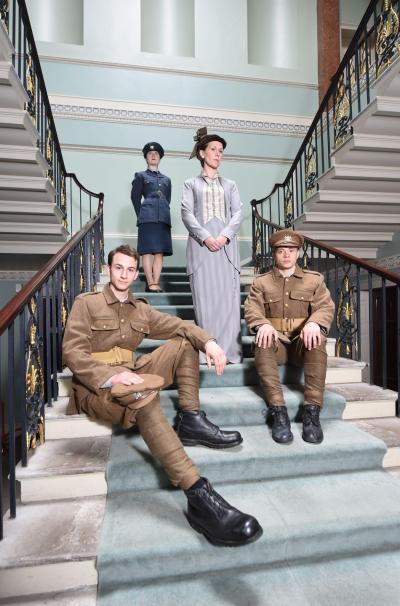Feelgood Theatre Productions and Tangled Dance Company have collaborated to present a world premier site-specific promenade theatre production of 'Whispers Of Heaton'.
For as long I have lived in the area, and for the many times I have visited Heaton Park over the years I have never been inside the building before. It is sadly still in quite a sad and sorry state of disrepair, but there are definitely some beautiful architectural and art-architectural elements still in place, such as the lovely marble pillars, the stucco work around the walls and ceilings, the beautiful small cupola-dome, the gilt-facing, and the piece-de-resistance, the beautiful organ and ornate painted organ-board taking pride of place in the Music Room. A few paintings still hang on the walls and some statues and statuettes still adorn the recesses. A most excellent setting for a period drama.
The play itself though was most definitely something of an enigma. The play was basically 2 plays with an epilogue. In the first play, 'The Fight' (written by Cathy Crabb and Lindsey Williams), we are presented with a story set in 1914. And as we move from room to room, we see a young couple in love, the girl pregnant and due at any moment, whilst her pugilist boyfriend is to fight for his regiment in a tournament being held at the army camp that has been set up in the grounds of Heaton Park. The girl is one of the under-staff at the Hall, and is friendly with a lady who is a propagandist fashioning herself on the famous local suffragette Margaret Ashton. As a time-lapse taking us from 1914 to 1941 the Tangled Dance Company - consisting of two young female dancers - performed 'Spilled Ink', taking as the theme, letters sent to and from the front and of the horrors facing those at the front; the shell-shock and insufferable inhumanity of it all, and of course the death. This takes us in to the Second World War, and now we see the baby from 1914 as a 27 year old in the Air Force back at Heaton Hall for Parade Day. 
The first play is over and we move again to another room to watch the second play. This time all in one room - no moving. This is the story of 'The Unknown Bugler' by Peter Kerry, and is the much more mature and dynamic of the two plays. A very cleverly interwoven 2 plays in one here, as we are presented with a monologue by the wife of composer Ralph Vaughan-Williams, and a duologue about a young bugler in World War 1 and the daughter of the Hall caretaker, which although at first appear unconnected, by the end of the story are inextricably linked. The ending being especially emotive and poignant.
We were then all ushered into the final room for what was effectively an epilogue with all the cast together where we hear not just English but other nations too ruing the war and their losses, and the futility of it all. Words and phrases from the two plays were shouted out as dying memories of lost love. These were not just the whispers of Heaton, but the whispers of all who have been affected by conflict at any time.
It seemed like a really good idea, and should have worked, but somehow it all fell a little flat. The biggest disappointment for me was that although a site-specific piece of theatre, it could well have been performed anywhere, in any theatre or theatre space. In fact may well have worked much better had it have been. It felt 'arty' and false, the style of presentation lending itself more to a theatrical venue than a real one. Moreover, I had thought, or hoped, that I might have learned about and even 'met' some of the real-life characters who have inhabited Heaton Hall, and leaned more about them and their stories, rather than some fairy story built around an actual historical happening, a long and somewhat unnecessary dance, and about Vaughan Williams and his inspiration for his latest composition. These themes were oh so tenuously connected to Heaton Hall they might as well have been anywhere.
I liked the design by Allison Clarke, whereby each room and passageway was decorated with papier-mache WW1 soldiers' helmets with their names written on them. Not certain about the flat boards with the words written on them though.
The directing, by Caroline Clegg, was somewhat indulgent and slow. I liked the idea of using a cellist to play mood music underscoring the dialogue, but as I was sitting in one room directly in front of the cellist it was too loud to hear some of the speaking. The whole sequence on the staircase could easily have been cut, and lost nothing.
The performance lasted about 95 minutes through, and despite some really rather good acting (especially from Jon-Paul Bell) and realistic costumes, seeing inside the Hall was definitely the highlight.
Reviewer: Mark Dee
Reviewed: 27th May 2016

